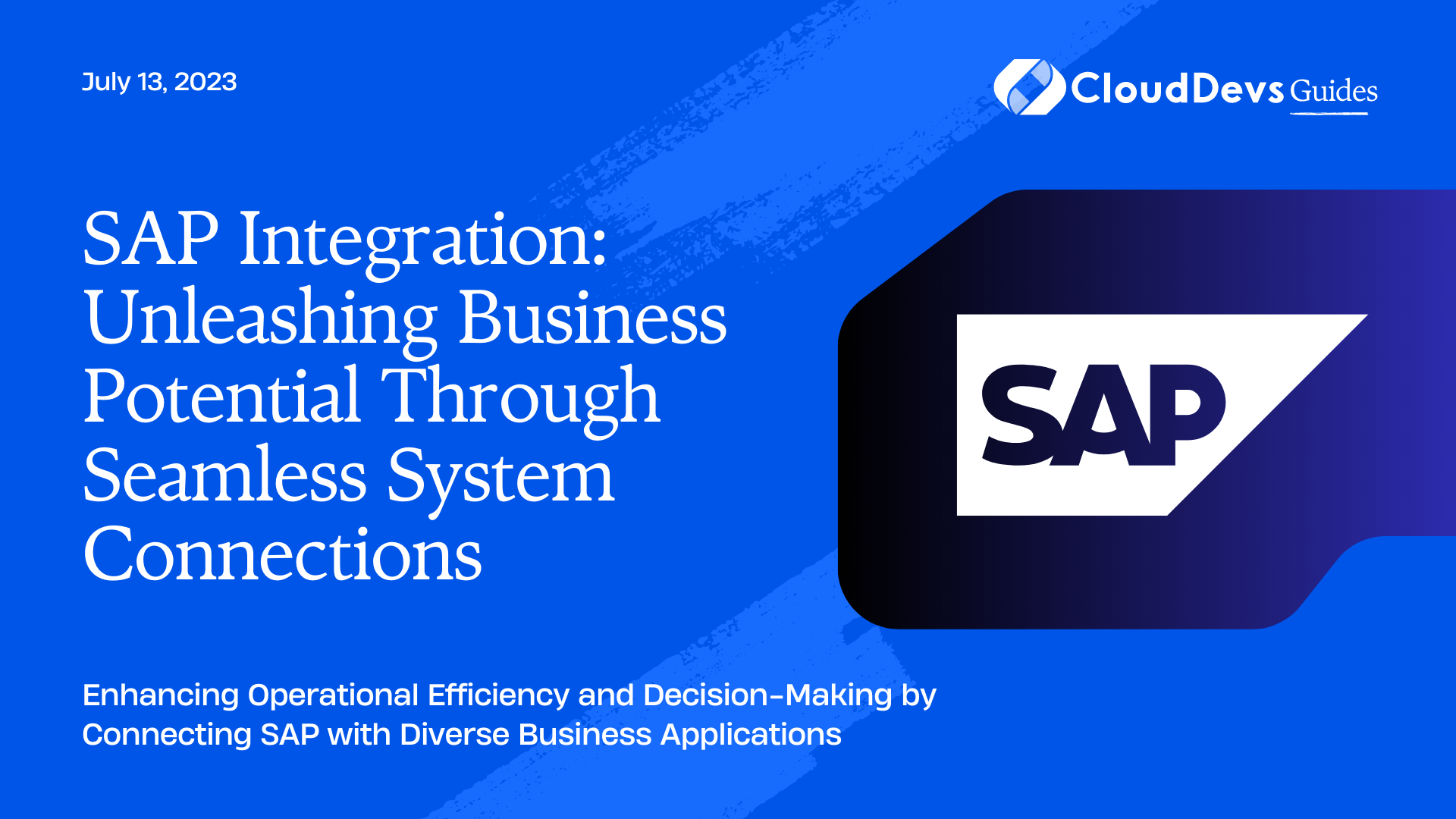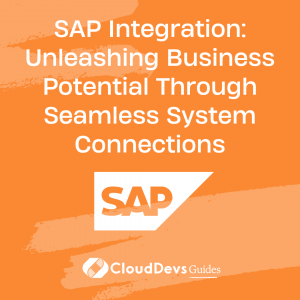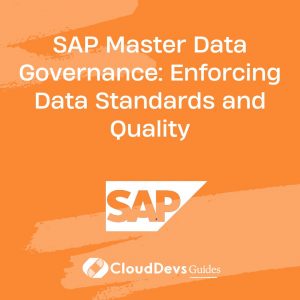SAP Integration: Unleashing Business Potential Through Seamless System Connections
When it comes to running a successful business in today’s hyper-connected world, ensuring seamless integration between different IT systems, databases, and applications is more than a luxury; it’s a necessity. One such platform that businesses frequently need to integrate with other systems is SAP, a world leader in enterprise resource planning (ERP) software. Achieving successful SAP integration often requires specialized knowledge and skills, which is why many businesses choose to hire SAP developers.
SAP integration, when done right, can lead to streamlined operations, improved decision-making, enhanced collaboration, and overall business growth. Given the complexity and potential impact, many companies decide to hire SAP developers who can handle the integration process with expertise and precision.
This blog post will delve deep into the nuances of SAP integration, using practical examples to illustrate its value. It also highlights the importance of having experienced professionals, such as hired SAP developers, to ensure successful and impactful integration.
What is SAP Integration?
Before we proceed, it’s essential to understand what SAP integration entails. Essentially, it’s a process of connecting SAP-based ERP systems with other business applications—whether they are SAP or non-SAP, on-premise or cloud-based—enabling them to exchange data and function together as a cohesive unit.
This integration makes it possible for companies to automate their business processes, reduce data duplication, increase accuracy, and derive strategic insights, all of which translate into better business outcomes.
Types of SAP Integration
There are generally two types of SAP integration: point-to-point and middleware integration.
- Point-to-Point Integration: This form of integration is typically used for systems with fewer interfaces and touchpoints. It’s a direct connection between two systems, where data is exchanged without any intermediary. However, as the number of systems increases, the complexity grows exponentially, making it a less suitable option for large-scale integrations.
- Middleware Integration: Middleware serves as a ‘middleman’ that connects various applications and allows them to communicate. SAP provides its own middleware known as SAP Process Orchestration (PO), which simplifies the connection of diverse systems, including web services, databases, and other applications. Middleware integration provides more scalability and control over business processes, making it ideal for large organizations.
Examples of SAP Integration
Now, let’s explore some practical examples of how businesses can leverage SAP integration to streamline operations and drive growth.
Example 1: SAP Integration with CRM Systems
A customer relationship management (CRM) system plays a critical role in managing a company’s interactions with current and potential customers. It holds valuable data about customer preferences, purchase history, and communication records. Businesses that hire SAP developers can take advantage of their expertise to integrate a CRM system like Salesforce with SAP, leading to a unified view of customer data.
For instance, when a sales representative closes a deal on Salesforce, the details can be automatically updated in the SAP system. Achieving this level of automation and accuracy often requires the skills of SAP developers. Their experience ensures the integration eliminates the need for manual data entry, reduces the chances of errors, and accelerates the order-to-cash process.
By deciding to hire SAP developers for such integrations, businesses can ensure seamless data flow, minimize potential pitfalls, and focus on what they do best – serving their customers.
Example 2: SAP Integration with E-commerce Platforms
In today’s digital age, e-commerce platforms like Shopify or Magento have become indispensable for businesses. Integrating these platforms with SAP can streamline various operations, from order management to inventory control.
Imagine an e-commerce store that sells custom-made clothing. When a customer places an order, the SAP system automatically updates inventory levels and triggers a production order if the stock falls below a certain threshold. Once the product is ready, the shipping details are updated on the e-commerce platform, and the customer is notified. This automation reduces order fulfillment times, improves customer satisfaction, and allows for real-time inventory management.
Example 3: SAP Integration with Supply Chain Management Systems
Supply chain management (SCM) systems, such as Oracle SCM, are pivotal in overseeing and managing the flow of goods, data, and finances involved in manufacturing, warehousing, transportation, and delivery. Integrating SAP with SCM systems can help businesses optimize their supply chain operations, a task that often prompts organizations to hire SAP developers for their unique expertise.
For instance, a global manufacturing company could hire SAP developers to leverage this integration to manage its supply chain more efficiently. Whenever a new purchase order is created in SAP, it can trigger a sequence of events in the SCM system, such as scheduling production, updating inventory, and initiating shipment to the designated location.
A professional SAP developer can ensure the integration between these systems is seamless, reducing potential delays or errors. This integrated approach, facilitated by the expertise of hired SAP developers, enhances visibility into the supply chain, reduces operational costs, and improves delivery timelines, giving businesses a competitive advantage in today’s fast-paced market.
Implementing SAP Integration
Successfully implementing SAP integration requires thorough planning, understanding of the current IT landscape, and technical expertise. Here are some steps to consider:
- Identify Integration Points: Determine which systems need to be integrated with SAP. These could be CRM systems, e-commerce platforms, supply chain management systems, among others.
- Select Integration Method: Based on the complexity, scale, and business needs, decide whether point-to-point or middleware integration would be more suitable.
- Define Data Flow: Establish how data will flow between systems. Will it be bidirectional, or will one system be the primary source of data?
- Develop & Test: Develop the necessary integration interfaces or APIs, followed by rigorous testing to ensure data accuracy and security.
- Deploy & Monitor: Once the integration is live, continuous monitoring is essential to ensure optimal performance and handle any issues that arise promptly.
Conclusion
In the era of interconnected business operations, SAP integration stands as a key component for promoting efficiency, collaboration, and data-led decision-making. The integration unlocks immense value, propelling business growth. However, due to the complex nature of this process, many businesses opt to hire SAP developers, specialists who can ensure a successful integration.
Hiring SAP developers enables businesses to navigate SAP integration more smoothly, whether it involves enhancing customer experience by linking SAP with CRM systems, fine-tuning e-commerce operations, or improving supply chains. Their expertise in SAP’s complex landscape and the ability to tailor integrations are instrumental in meeting unique business needs.
Ultimately, the goal goes beyond mere system integration; it aims to build a seamless information ecosystem for higher efficiency and innovation. The decision to hire SAP developers is a strategic move towards this goal.
Table of Contents









